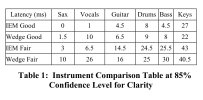fractalz
Power User
I think you are conflating the ability to detect whether or not two signals playing back have relative latency versus being able to detect latency between a sound you initiate (eg with the pick) and it's onset through the speaker.Further down in the paragraph you quote it says - Conversely the keyboard, electric guitar, and electric bass instruments have little or no direct sound. Although they will have no physical artifacts such as comb filtering, psychophysical effects may still be present.
And again there’s no effect from comb filtering when using IEMs. But believe it or not I have no axe to grind here and also no latency issues with my FM3. What I do question is whether the 5 ms floor claimed as absolute is indeed definitive. It wouldn’t be surprising if that number originated in telephony where for comprehensibility latency is a major consideration. But musicians are a non-representative subset of the population when it comes to hearing and listening. And even within this subset there is great deal of variability. So when some musicians speak of ‘feel’ when discussing analog and digital I wonder if they may be referring to a subliminal effect of latency perception. But I’ll drop this in good faith now that the acolytes are flocking in.
You can easily test yourself on the former by taking a mono track, send it to a stereo output, and delay one side. Can you hear 1ms delay? 5ms?
On the latter, plug in to an amp, move 10' away. Can you feel that delay compared to being 1' away?
If you stand 10' behind the speaker, do you hear the sound 10ms before you pick?
Last edited:



